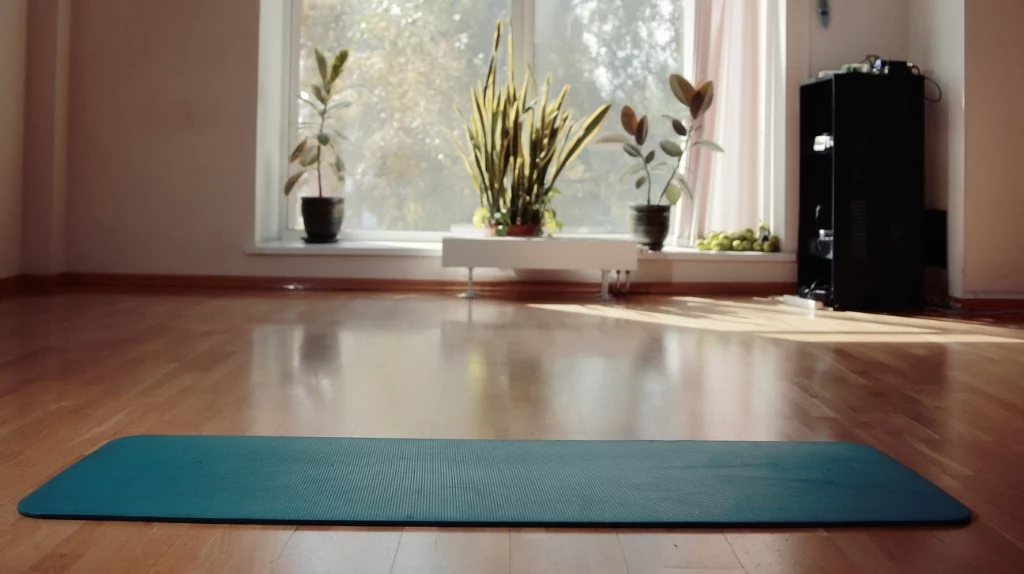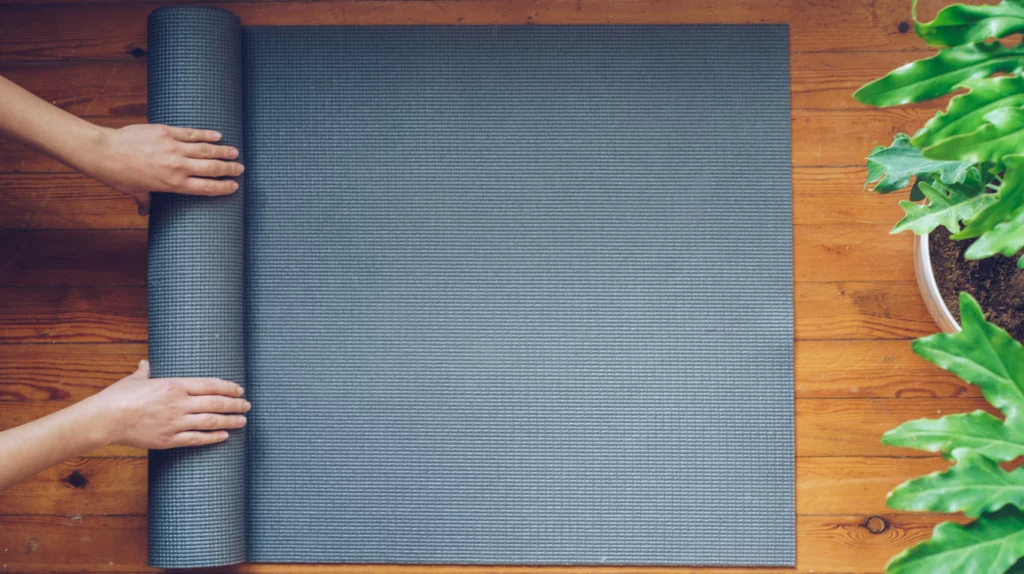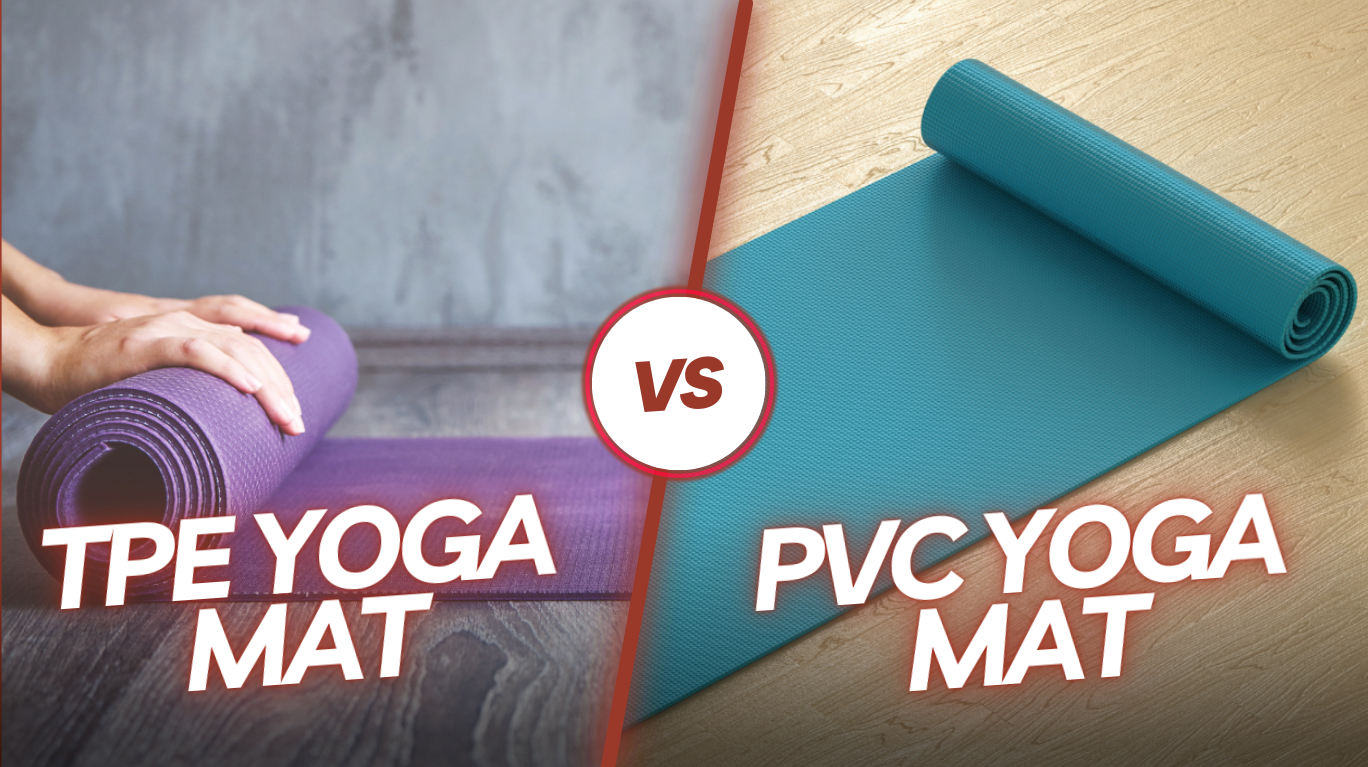When it comes to finding the perfect yoga mat, the debate between TPE and PVC can leave you feeling tied up in knots. You aim for a serene yoga session. Picking the wrong mat can lead to tumbling, nasty odors, and a compromised connection to the earth.
TPE yoga mats tout their eco-friendly, non-toxic composition, but do they sacrifice performance? PVC yoga mats offer durability, but at what cost to the environment and your health?
In this guide, we’ll untangle the perplexities of TPE vs PVC yoga mat. This will help you find the ideal mat to support your mindful movement.
TPE Yoga Mats

TPE is a type of material known as thermoplastic elastomer. TPE is an attractive choice for yoga mats because it is super flexible and durable. TPE yoga mats are made from a mix of polymers using a recyclable process, making them eco-friendly. This composition and manufacturing process make TPE mats appealing, as they are non-toxic and sustainable.
TPE yoga mats boast a range of properties that make them stand out in the world of yoga accessories. Their cushioning is top-notch, providing a comfortable surface for yoga practitioners. The non-slip nature of TPE mats offers stability and security during poses. This makes them a reliable choice for various yoga styles.
Additionally, TPE yoga mats are known for their eco-friendly nature, as they are free from PVC, latex, and other harmful substances.
Advantages of TPE Yoga Mats
Choosing a TPE yoga mat comes with a host of benefits.
- These mats are lightweight, so you can easily carry them to and from your yoga sessions.
- TPE yoga mats are better for the environment because they’re made with non-toxic and metal-free materials.
- TPE mats are recyclable, making them a more sustainable choice.
- TPE mats are easy to maintain since they need simple cleaning to keep them in top condition for your practice.
- Furthermore, TPE yoga mats provide relief for individuals with allergies. They are hypoallergenic and cater to a broader range of users.
Disadvantages of TPE Yoga Mats
While TPE yoga mats offer many desirable features, they do have some potential drawbacks to consider.
- TPE mats come in limited color options. This may limit personalization preferences for some users.
- Additionally, durability can be an issue for TPE yoga mats, as they may show signs of wear and tear more quickly.
- TPE mats usually cost more.
- It’s also important to know that TPE mats can be sensitive to specific cleaning products, so be careful when keeping them clean.
PVC Yoga Mats

PVC, which stands for polyvinyl chloride is a type of plastic material used in many items, such as yoga mats. PVC is a popular choice for making yoga mats because it is durable and flexible. These qualities make it valued in the manufacturing process. Plus, this material can endure a lot of use without getting damaged. It gives a dependable surface for doing yoga.
PVC yoga mats are known for being durable. They have a strong surface that can handle regular use. The mats provide comfort and support during yoga poses, making the practice enjoyable.
Moreover, PVC mats resist moisture, keeping sweat away and maintaining cleanliness during workouts.
Advantages of PVC Yoga Mats
PVC yoga mats present several advantages that make them appealing to yoga enthusiasts.
- PVC yoga mats are usually inexpensive. This makes them a cost-effective option for people who want a reliable yoga mat without spending a lot of money.
- These mats are durable and can endure over time with the right care.
- PVC mats are easy to carry due to their lightweight design, making them convenient for on-the-go use.
- They give a good grip and traction, perfect for beginners.
- Further, PVC mats are effortless to clean. They require minimal maintenance to keep them in top condition.
- Moreover, PVC yoga mats come in a variety of designs and colors. Users can choose a mat that matches their style and preferences.
Disadvantages of PVC Yoga Mats
While PVC yoga mats have their benefits, it’s important to consider their potential drawbacks.
- PVC yoga mats are not good for the environment.
- They don’t break down easily and can take hundreds of years to decompose.
- Plus, PVC mats often have a strong smell, especially when they’re brand new.
Comparative Analysis of TPE vs PVC Yoga Mats
Yoga mats are a must for a comfy and safe practice, offering the right cushioning and support. Two common materials used for yoga mats are TPE and PVC. In this comparative analysis, we will explore the key differences between these two materials to help you make an informed decision.
| Features | TPE Yoga Mats | PVC Yoga Mats |
| Cost | TPE yoga mats are affordable and provide good value. | PVC yoga mats are budget-friendly and relatively inexpensive. |
| Environmental Impact | TPE yoga mats are biodegradable and eco-friendly. This makes them a more sustainable choice. | PVC yoga mats are not biodegradable and can have a potential environmental impact. This is due to the manufacturing process and the non-biodegradable nature of PVC. |
| Comfort & Cushioning | TPE yoga mats provide excellent cushioning and offer a supportive surface for various yoga poses. | PVC yoga mats also offer good cushioning, making them suitable for yoga practice. |
| Traction & Resistance | TPE yoga mats provide a stable feel during yoga sessions with medium traction. | PVC yoga mats offer good traction and high resistance. This can be beneficial for maintaining balance during challenging poses. |
| Durability & Longevity | TPE yoga mats have moderate durability and an average lifespan. They are suitable for regular use if taken care of properly. | PVC yoga mats are known for their durability and long-lasting nature. This makes them a reliable choice for users looking for a mat with a longer lifespan. |
| Maintenance | TPE mats are easy to clean and maintain. They require simple cleaning routines to keep them in good condition. | PVC mats are also easy to clean and maintain. Regular cleaning and proper storage can help prolong the life of these mats. |
Conclusion
In conclusion, it’s important to weigh the differences when comparing TPE vs PVC yoga mat. TPE mats are more environmentally friendly and recyclable. On the other hand, PVC mats offer better grip and durability. For a more sustainable option, individuals may opt for TPE yoga mats. While those prioritizing grip and lasting performance may lean towards PVC yoga mats. In the end, the decision depends on personal values and yoga practice needs. So choose the mat that aligns with your priorities.
Common Queries
Which is a better choice for a yoga mat, PVC or TPE?
PVC yoga mats are strong and offer good grip. However, they are less eco-friendly and may contain harmful chemicals. TPE yoga mats are safe and eco-friendly, made from recyclable materials. They offer a comfy cushion and a good grip. Choose TPE mats for the environment and overall health.
Can PVC be used for yoga mats?
PVC can be used for yoga mats, but it is not the most eco-friendly or health-conscious option. It is durable and offers a good grip but may contain harmful chemicals.
What materials are used to make TPE yoga mats?
TPE yoga mats are made from thermoplastic elastomers, which are non-toxic and recyclable. They are more environmentally friendly and safer for overall health.
Are PVC and TPE yoga mats the same?
PVC and TPE yoga mats differ in material composition and environmental impact. PVC mats are not very good for the environment and might have toxic chemicals. On the other hand, TPE mats are made from materials that are not harmful. They can be recycled, and are safer for both the body and the planet.
Is it safe for babies to use PVC yoga mats?
It is not recommended for babies to use PVC yoga mats, as they may contain harmful substances. TPE yoga mats are a safer choice for infants and young children due to their non-toxic nature.
Are TPE yoga mats suitable for hot yoga?
TPE yoga mats are ideal for hot yoga due to their non-slip and moisture-resistant properties. They provide good grip and support during hot and sweaty yoga sessions.

